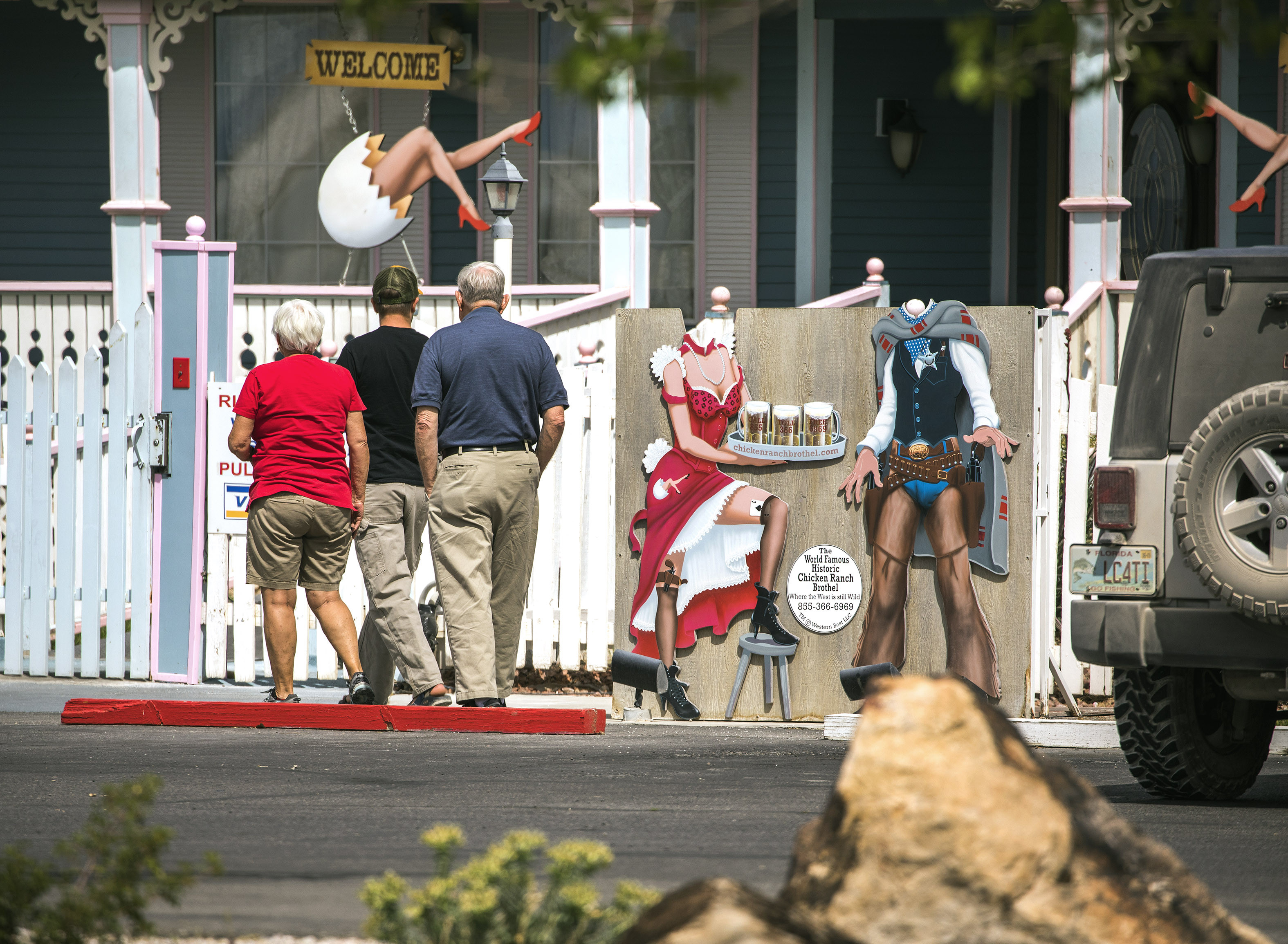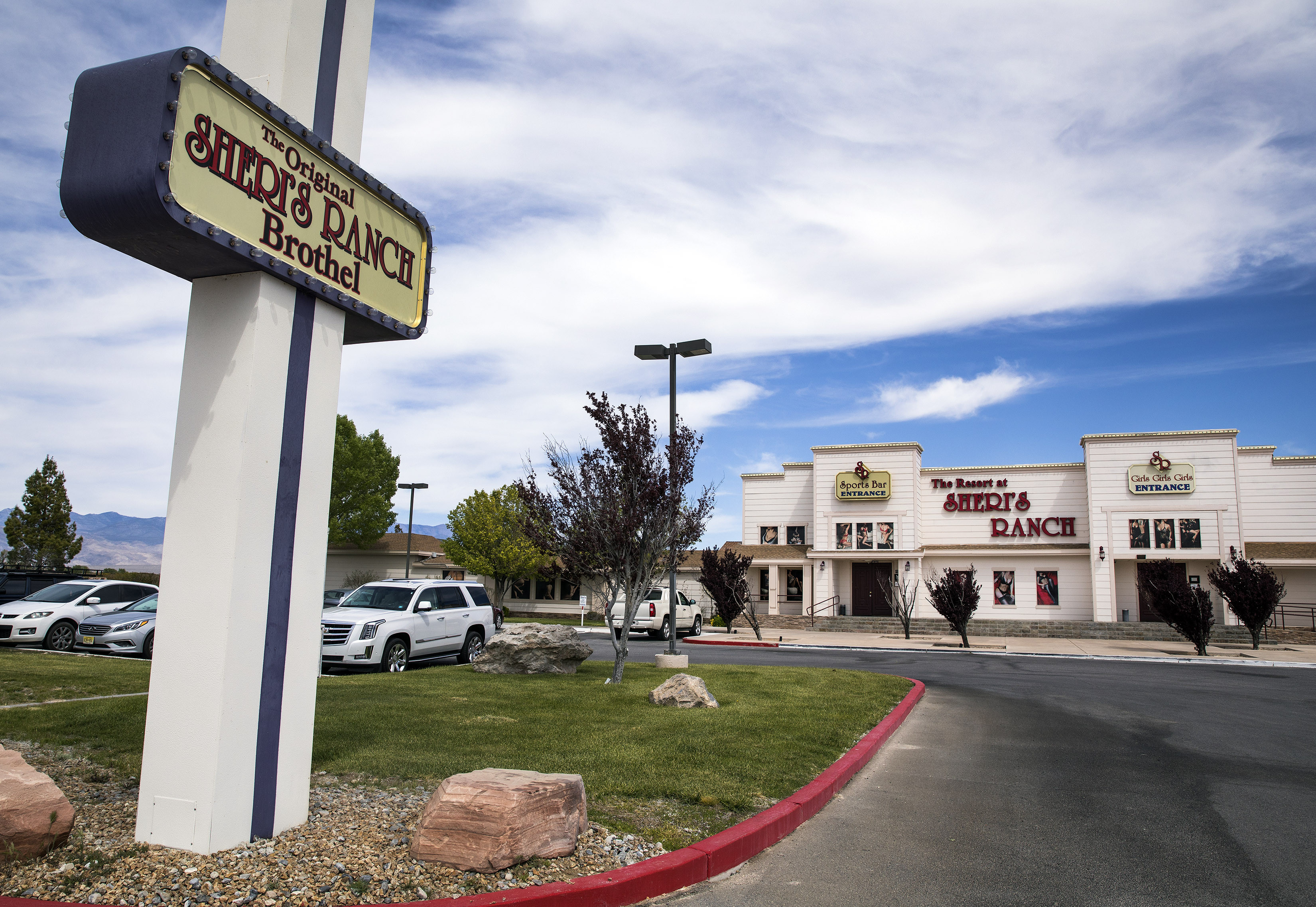Nevada holds a distinctive position in the United States as the sole state where prostitution is legal. This unique status has consistently drawn attention, particularly as discussions around banning brothels in certain counties arise and a prominent brothel owner campaigns for a seat in the Assembly.
Dennis Hof, a well-known figure in Nevada’s brothel industry and a political aspirant, described Nevada in his 2015 biography as “probably the last live-and-let-live state in the country.” His sentiment reflects a broader perception of Nevada’s libertarian approach to certain social issues.
However, for tourists and others intrigued by Nevada’s reputation for vice, it’s crucial to understand the specific regulations governing the sex industry. Legal prostitution in Nevada is far from a free-for-all; it operates under strict geographical limitations. Even within the industry, opinions vary on whether Nevada’s regulated model is effective or morally sound.
This article delves into the key aspects of legal prostitution in Nevada, addressing common questions and clarifying the nuances of this complex issue.
 People stand outside the Chicken Ranch brothel in Pahrump on Thursday, April 19, 2018. (Jeff Scheid/The Nevada Independent)
People stand outside the Chicken Ranch brothel in Pahrump on Thursday, April 19, 2018. (Jeff Scheid/The Nevada Independent)
Image alt text: Patrons gather outside the Chicken Ranch brothel in Pahrump, Nevada, illustrating the public face of legal prostitution in the state.
The Historical Context of Legal Prostitution in Nevada
Nevada’s history with prostitution stretches back to the state’s mining boom in the 19th century. While many parts of the US began to prohibit prostitution in the early 20th century, Nevada maintained a more tolerant stance. Initially, prostitution wasn’t explicitly legal, but it was largely tolerated, particularly in brothels, while activities like streetwalking were more likely to be curtailed under vagrancy laws.
The anti-prostitution movement gained momentum nationwide after the Civil War, often linked to abolitionist sentiments and initially targeting the licensing of brothels. Between 1911 and 1915, numerous laws were enacted to combat the exploitation of women and girls in prostitution.
Nevada, however, resisted this trend. While brothels operated openly for decades, it wasn’t until 1971 that Storey County officially legalized Joe Conforte’s Mustang Ranch Brothel. This marked a turning point, establishing Nevada’s first officially legal brothel, as historian Guy Rocha explained to the Reno Gazette-Journal. This formal sanctioning solidified Nevada’s unique legal approach to prostitution in the United States.
Geographical Limitations: Where Are Brothels Permitted?
Nevada law explicitly prohibits both solicitation and prostitution unless it occurs within a licensed brothel. This immediately restricts where legal sex work can take place. Further narrowing the scope, state law bans licensed brothels in counties with populations exceeding 700,000. Currently, this population threshold applies to Clark County, which encompasses Las Vegas, effectively making brothels illegal in Nevada’s most populous area.
In practice, only ten of Nevada’s sixteen counties permit prostitution, and even within these counties, it’s confined to licensed brothels. Churchill County, for example, technically allows prostitution, but the last brothel license there was surrendered in 2004, meaning there are no active brothels.
The counties that broadly permit brothels throughout their jurisdiction include Esmeralda, Lander, Mineral, Nye, and Storey. Conversely, Elko, Humboldt, Lyon, and White Pine counties have more localized regulations, permitting brothels only in specific incorporated communities within their boundaries.
Prostitution remains illegal in Clark, Washoe, Carson City, Pershing, Douglas, Eureka, and Lincoln counties. This prohibition covers major urban centers like Las Vegas and Reno, as well as the state capital, Carson City. Therefore, while Nevada is known for legal prostitution, its availability is geographically restricted to specific, mostly rural, counties.
The Number and Location of Nevada’s Brothels
Recent counts, such as one by the L.A. Times in early May, indicate approximately 20 operational brothels in Nevada. These establishments are concentrated in counties where prostitution is legal.
Nye County is home to four brothels, including two previously owned by the late Dennis Hof. Lyon County also hosts four, all of which were under Hof’s ownership.
The remaining brothels are scattered across other permissible counties. Storey County features the Mustang Ranch in Sparks. Mineral County has the Wild Cat Brothel in Mina. White Pine County is home to two: the Stardust Ranch Brothel and Big 4 Ranch in Ely. Lander County houses the Hot Desert Club Girls in Battle Mountain. Elko County boasts the highest number with seven brothels, including Dove Tail Ranch and Sharon’s Brothel and Bar in Carlin, Desert Rose Gentlemen’s Club, Inez’s D&D, Mona’s Ranch, and Sue’s Fantasy Club in Elko, and Bella’s Hacienda Ranch and Donna’s Ranch in Wells.
This distribution highlights that legal prostitution in Nevada is not widespread throughout the state but rather concentrated in specific, less populated areas.
Taxation and Revenue from Nevada Brothels
While Nevada brothels and sex workers are required to pay state business license fees, there is no specific excise tax levied directly on sex acts themselves. This contrasts with other regulated industries that often face specific consumption or “sin” taxes.
In 2009, a proposal emerged to introduce a $5-per-day tax on customers of prostitution services. State Senator Bob Coffin, a Democrat, sponsored a bill estimating that with around 400,000 customer days annually in Nevada’s legal brothels, this tax could generate $2 million in revenue.
Despite projected revenue and some support within the industry, the bill failed to pass a committee vote and did not progress in the legislature. Then-Republican Governor Jim Gibbons publicly opposed the tax, stating to NPR his disapproval of legalizing prostitution and arguing that taxing it would legitimize it further, a position he did not support. This political resistance has contributed to the continued absence of a specific tax on prostitution services in Nevada.
Attempts to Ban Legal Prostitution in Nevada
Despite its long history, legal prostitution in Nevada has faced challenges and attempts at prohibition. In 2011, then-Senate Majority Leader Harry Reid, a Nevada Democrat, urged state legislators to ban prostitution. He argued in a speech to lawmakers that Nevada should be known for innovation and investment, not as the “last place where prostitution is still legal.” Reid cited concerns from business leaders visiting Storey County who were surprised by the presence of legal brothels.
However, Reid’s call to action did not result in legislative changes. Governor Brian Sandoval at the time indicated that the issue was best left to individual counties to decide, reflecting a decentralized approach to the regulation of prostitution in Nevada.
More recently, renewed efforts to ban prostitution have emerged at the county level. Movements to prohibit brothels through county-wide ballot initiatives have gained traction in both Lyon and Nye counties. These local efforts signal ongoing debate and potential shifts in the legal landscape of prostitution in specific parts of Nevada, even if a statewide ban remains unlikely.
Advertising Regulations for Nevada Brothels
Nevada law places restrictions on how brothels can advertise their services. Specifically, brothels are prohibited from advertising in jurisdictions where local ordinances or state laws ban prostitution. This prevents brothels from promoting their services in counties where they are illegal.
Even in counties where brothels are legal, advertising is restricted. Nevada law prohibits brothel advertising “in any public theater, on the public streets of any city or town, or on any public highway.” This limits visibility and public promotion, channeling advertising efforts towards more discreet methods and locations.
 Sheri's Ranch brothel in Pahrump is seen on Thursday, April 19, 2018. (Jeff Scheid/The Nevada Independent)
Sheri's Ranch brothel in Pahrump is seen on Thursday, April 19, 2018. (Jeff Scheid/The Nevada Independent)
Image alt text: A daytime view of Sheri’s Ranch brothel in Pahrump, Nevada, showcasing the discreet nature of brothel locations and advertising.
The Cost of Services in Nevada Brothels
The pricing for services at Nevada brothels is variable and negotiated directly between sex workers and clients. Brothel workers set their own rates for “parties,” or sexual encounters, based on a menu of services offered.
Christina Parreira, a sex worker at one of Dennis Hof’s brothels, told The Nevada Independent that she typically does not engage in intercourse for less than $1,000. This provides a glimpse into the higher end of pricing.
Longer engagements and more comprehensive experiences command higher prices. Extended interactions like overnight stays or the “Girlfriend Experience,” which incorporates non-sexual activities resembling dates, can cost around $1,000 per hour. Dennis Hof’s autobiography details instances of clients paying for lavish, extended “parties” lasting days, weeks, or even months, with some reaching costs exceeding $2 million.
However, prices can also be significantly lower. T.J. Moore, a former madam at the Love Ranch South brothel, stated that prices for sex often ranged from $300 to $400, but could sometimes drop as low as $80. This wide range reflects negotiation, service types, and market dynamics within the brothel industry.
Compensation and Working Conditions for Nevada Prostitutes
Sex workers in Nevada brothels typically operate as independent contractors. Dennis Hof stated in his book that workers at his brothels keep half of their earnings, with the brothel retaining the other half to cover operational costs. Workers are also responsible for their own expenses, including rent, food, transportation, and taxes. They do not receive traditional employee benefits like health insurance, vacation pay, or retirement plans.
Prostitutes are required to undergo weekly STD testing and obtain sex worker registration cards, with costs varying by county. Nye County, for example, charges prostitutes $150 per quarter for registration and an additional $150 annually.
While the industry frames this arrangement as “independent,” some, like T.J. Moore, critique this label. They point to brothel policies governing workers’ movements and pressures to actively solicit clients online as factors that limit true independence. These perspectives highlight ongoing debates about the nature of work and worker rights within Nevada’s legal prostitution industry.
Revenue Generated for Local Governments from Brothels
The financial contributions of brothels to local governments in Nevada vary by county. These revenues come primarily from worker registration fees and brothel license fees.
In the last fiscal year, Nye County collected $141,779 from worker registration cards and brothel licenses. Brothel license fees in Nye County are tiered based on size, ranging from just over $2,300 per quarter for brothels with up to five prostitutes to $46,900 per quarter for larger brothels with 26 or more workers.
Lyon County’s brothel license fees range from approximately $20,000 to $26,000 per quarter, depending on the number of rooms. Annually, Lyon County generates around $384,000 in revenue from brothel license, liquor license, and business license fees across its four brothels.
Dennis Hof, in his book, emphasized the positive impact of these revenues, stating that “those taxes support doctors, a police force, EMTs, and even the public schools.” This highlights the argument that legal prostitution, through taxation and fees, contributes to essential public services in Nevada counties where it operates.
Age Requirements for Prostitutes in Nevada
The minimum age to work as a prostitute in Nevada varies by county. Nye County, for example, sets the minimum age at 21 years old. In contrast, Lyon County has a lower age requirement of 18. This county-level variation reflects local regulatory differences within Nevada’s framework of legal prostitution.
Diverse Perspectives on Brothel Work
Experiences and opinions on working in Nevada’s legal brothels are diverse. Christina Parreira, a doctoral candidate who conducted research within brothels, found her experience working at the Alien Cathouse to be “a lot of fun” and enjoyed the “familial atmosphere.” She described it as “just a job” that provided companionship and sex as a service.
Madam Suzette Colette Cole of the Moonlite Bunny Ranch acknowledged the challenges of brothel work, noting that “every day is a party for the client, but it can be hard on the girls, both physically and psychologically.” She highlighted the potential emotional toll of the lineup process where workers compete for clients’ attention.
Ruby Rae, a prostitute working in one of Hof’s brothels, emphasized the agency workers have, stating, “In the brothels, we have the choice, always, to say which clients we will say yes and no to.” This reinforces the narrative of worker autonomy within the regulated brothel system.
Lexi James, a worker at Love Ranch North, publicly defended brothels, stating, “What I do is not sex. I sell love. I provide services to disabled clients, widowers, divorcees, helping couples spice things up.” She rejected moralistic criticisms of her profession.
Cara Rain, another brothel worker, urged voters to become more informed about the industry, stating, “I chose this profession without ever being in the sex industry prior and I’m completely happy here.”
However, not all perspectives are positive. T.J. Moore expressed a more critical view, contrasting the reality of brothel work with the glamorized portrayal in media like the HBO show Cathouse. She observed that many workers faced substance abuse issues and economic hardship, struggling to improve their situations through brothel work. Diana Grandmaison, a former pornography actress who briefly worked in Nevada brothels, described the experience as demeaning and the pay as barely sufficient. She now opposes prostitution in all forms, legal or illegal.
These varied accounts illustrate the complex and often contradictory realities of legal prostitution in Nevada, encompassing elements of empowerment, agency, exploitation, and hardship, depending on individual experiences and perspectives.
Conclusion: Navigating the Legal Landscape of US Prostitution
While the question “Where Is Prostitution Legal In The Us?” often leads to Nevada, the answer is nuanced. Legal prostitution in the United States is essentially confined to licensed brothels within specific, mostly rural counties in Nevada. It is illegal in major Nevada cities like Las Vegas and Reno, and prohibited in every other state.
Nevada’s unique legal framework represents a long-standing, albeit geographically limited, experiment in regulating prostitution. This system generates revenue for some local governments and provides a legal avenue for sex work within defined boundaries. However, it also faces ongoing challenges, including moral objections, debates about worker rights, and persistent efforts to ban brothels at the local level. Understanding these complexities is crucial for anyone seeking to comprehend the legal and social realities of prostitution in the United States.

